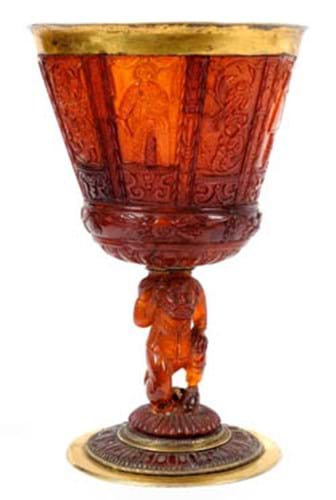
The cup, standing 8¼in (21cm) high with a 5in (13cm) diameter bowl, was carved from warm golden amber and decorated with panels of floral scrolls, alternating with male and female portraits above swags of fruit - perhaps emblematic of marriage.
The stem was carved as a figure of a kneeling man, while both the foot and the rim were mounted with silver-gilt.
In construction it follows a technique developed in the amber-making centre of Königsberg in the 17th century. Rather than carved from a single nugget of fossilised resin, this was fashioned from thinly-cut plates of amber, decorated in low relief, and then joined together using adhesives.
Similar examples (including those forming part of the Waddesdon bequest in the British Museum and another in the Grunes Gewolbe, Dresden, have been ascribed to the maker Jacob Heise, a member of the amber workers' guild formally established in 1641, who worked for the court in Königsberg from 1654 to 1663.
Artefacts made of 'Baltic gold' were fashionable among the highest classes of society.
This cup had been in the possession of the Bailward family at Horsington Manor, near Templecombe, Somerset, since the 19th century and the auctioneers had long known of its existence. The bowl and stem have long been separated from the foot and were held together by Blu-Tack to enable a good photograph to be taken.
The estimate of £15,000-20,000 for the sale on October 11 acknowledged the damage as well as the rarity.
Over a dozen telephone lines booked by British and Continental dealers and collectors were reserved for it. After a lengthy tussle the cup was bought by a UK dealer for £210,000 (plus 19.5% buyer's premium).
By Roland Arkell




